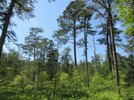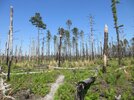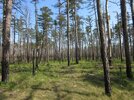I’ve never heard quail in Wharton or adjacent lands. Have heard them in Salem County near running deer golf club.
I wouldn't expect to hear any in Wharton or any state managed lands. Not in their present condition. These would be on the private lands owned by the Haines family and the Pine Island Cranberry growers. The ones in Salem County were likely farmed and released, not wild birds.
The large quail population that many old timers recall was likely the result of widespread clearing for activities such as farming and charcoal production, which consumed vast areas of forest during the iron and glass production eras. Fires also naturally consumed much more forest back then, before the suppression techniques and equipment that we have today came into use. This also supported bluebirds and other early successional plant and animal species, including many of our rarest ones.
While there may have been more quail around in 1900 than in 1500, the present condition of the pineland's upland shortleaf-oak, and the pitch pine lowlands is not natural forest. It is definetly fire excluded. The stocking of the forest and fuel loads with a thick duff layer and no fire in decades is a pretty good indication of this. It is an overly dense 3rd and 4th (maybe 5th or greater) growth forest of negatively and poorly managed forest that has far more trees than there would be with a natural fire regime. The small diameter ones, not the larger diameter trees.
The disappearance of other fire dependent plant species from areas like the pitch pine lowlands and adjacent wetlands is a close parallel to the local extinction of species like quail. Huge areas of extremely dense pitch pine over an impenatrable shrub layer of just a few species is terrible for wildlife and humans, alike.
Fire, "consuming a forest", is the language used during the Dixie Crusade which was employed to cast fire strictly in a negative light and has led to a near complete eradication of ecosystems like longleaf pine, as well as many others, and the degradation of many other US ecosystems, the pinelands included, with the primarily shortleaf uplands and pitch lowlands, as well as adjacent wetlands existing in a highly degraded state. Even the oak dominated forests can be included.
It is ecologically aberrant for these ecosystems found in the pinelands to exist in their present state, but the emphasis in NJ seems to focus strictly on "preservation" from development with little consideration for the ecology of the system. It's a very urban view, one not grounded in reality, and the same outdated view that birthed the 1964 wilderness act and has led to total destruction of many western wilderness areas with moonscapes replacing a variety of fire dependent systems due to a century of fire exclusion, inability to manage and finally a hot stand replacing fire where formerly there was frequent lower intensity fire.
Many ideologically driven people shriek when they hear, "management", but by virtue of humans existing on the land we are managing. It is purely what I term negative managment, where fire is suppressed or excluded either directly or through road construction, and systems are mined for a resource with no further consideration for the future of the system. The state seems to do this a lot when they harvest oak for fuelwood, and then never return to manage the subsequent stand of pine that often regenerates post disturbance.
The NJ pinelands on the coastal plain is really just an extension of the Atlantic Coastal plain with it's high fire frequency and therefore lower fire intensities. Virtually every NJ pinelands enthusiast is aware of pitch pine with varieties that exhibit serotiny as well as the ability of it to produce epicormic sprouts after high intensity fire. Just as with pond pine further south, primarily in the Carolinas, there was also a component of moderate and high intensity fire occuring in areas at longer intervals. Today, with few exceptions, the only natural summer or growing season (leaved out time) fire in the pinelands today is the low frequency high intensity fires which occurred in some of the lowlands along US 206 a year or two ago; primarly uncontrolled wildfires.
Few people seem to be aware of Shortleaf pines ability to resprout as a seedling following top kill, or that shorleaf formerly was far more common and existed in fire depenent forests which were far more open than they are today. This also was not unique to NJ, although besides western Arkansas, NJ is one of the few places in the USA that still has a forest canopy where shortleaf exists as a primary component.
It isn't realistic to use growing season fire in interface areas, but relatively isolated areas of larger state forests could easily be managed with fire with a significant percentage of the prescibed fires being growing season. There just doesn't seem to be the will for this. It is a shame, as there is already an excellent network of existing breaks and roads that would lend themselves to larger burn blocks. Those white "roads" on the google sourced map would be great for that purpose, yet there appears to be no sign of fire in decades over much of that area. I observed little to no stem char on tree bark, and the duff and shrubs were universaly thick on ridges and in lowlands. Those 2 transects in the attached image I used to measure given an estimated area roughly 900 acres in size, which would be a great size to start with.
The populations we have now are what you'd expect in vast areas of more mature forest.
The quail went extinct in the pinelands in the 1980s or 1990s, per the audobon society. As I wrote earlier, this is not unique to NJ, and collecting birds across the south proved difficult for translocation to NJ for the 2018 releases.
https://njaudubon.org/northern-bobwhite-restoration-initiative/
I am curious what you mean by mature forest?
I have attached a few photos I took 2 days ago on my hike. They are from the northern and western side of the Penn Branch trail. 22low is the typical dense fire excluded shortleaf-oak mix, with a large number of younger shortleaf regeneration visible under an overstory of mature shortleaf. There is also a midstory of primarly post oak and unstory of heath shrubs.
35 and 39 are from the burned area on the west side. The 2 fires in summer have produced a great outcome for the ground cover, with a high diversity of plants. The fires that created this did not need to happen this way. In both images we see shortleaf, but there is also pitch pine. The density of the pines still appears higher than it is due to standing dead, but if this area was to continue to have growing season fires on a roughly 5 year mean return interval, and not those pathetic cold February fires once every decade that the state loves, in time this area could produce what I would call a mature shortleaf forest which was ecologically valuable and what early settlers encountered. The diversity of herbaceous plants in the open areas, but even under pine trees, was really high.
Maybe the audobon society could start to release some birds out there? Then again, the state may not want to be forced to manage for them, as would happen if RCWs were to suddenly pop up in an area of the Pinelands? lol





